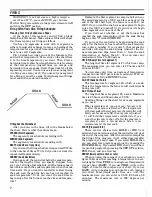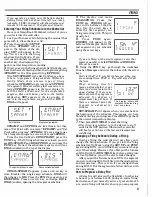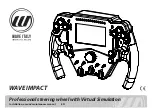
FIRING
WARNING! If you heat wax to a higher tempera
ture than 350· F., you could RUIN your furnace.
4.
Mter firing is completed, always tum element on/off
switch to the
OFF
position.
Firing With Your Own Firing Schedule
Planning Your Firing Schedule on Paper
At the back of this manual you will find a blank
Ramp/Soak Worksheet. Make copies of this worksheet.
Use them to plan your firings as follows:
You have
12
segments to work with. A segment is
either a temperature change (ramp), or a holding of the
temperature for a period of time (soak). But you do not
have to use all
12
segments.
First, decide how long you want the furnace to fire,
and to what temperature. Draw a line on the chart from
o
to the time/temperature you want. Then draw a
horizontal line to show how long the furnace is to remain
at that temperature. Angled lines are ramps, and
horizontal lines are soaks. Draw these lines for all the
segments you need. You can use as few as one segment
in a firing or as many as
12.
If you use only one segment
for a firing, it must be a soak. Multiple-segment firings
must end with a soak (odd number).
SOAK
SOAK
Filling Out the Worksheet
After you draw in the lines, fill in the blanks below
the chart. Here is what the entries mean:
STRSEG
(Start
Segment,
The segment your schedule is starting with.
ENDSEG (End Segment,
The segment your schedule is ending with.
RECYCL (Number of recycles,
Do you want the firing schedule to repeat itself? Write
in the number of times. Write
0
if you do not want it to
repeat itself automatically.
SOKDEV (Soak Deviation,
During a soak, the controller holds the soak tempera
ture for the length of time you specify. Suppose, how
ever, you're firing a fast schedule, and the furnace hasn't
been able to reach the soak temperature when the soak
time starts. Do you want the controller to start timing
the soak even though the furnace has not reached its
soak temperature? Or do you want the soak time to
begin only after the furnace reaches its soak tempera
ture?
7
Example: the first segment (a ramp) is half an hour.
The second segment is a
1000·
soak for one hour. At the
end of the first half hour, the furnace is at
800·,
not
1000·.
Do you want the one hour soak segment to begin
only after
1000·
is reached? Or do you want it to begin
when segment one runs out of time?
If you don't care whether or not the furnace has
reached the soak temperature when the soak timing
begins, enter
"0"
under
SOKDEV.
If you want the controller to begin timing the soak
only after the furnace has reached the soak tempera
ture, enter a number. If you enter
5,
that means the
controller will stop the soak timing whenever the
fur
nace temperature dips lower than
5·
from the soak
temperature, or higher than
5".
You can enter any
temperature from
1
to
99
degrees.
SG1 RP (Ramp Tlma for Segment
1,
The length of time for segment
#1,
which is a ramp.
The maximum time you can enter is
99
hours and
59
minutes
(99.59).
You
can
also enter time as degrees of temperature
rise per minute
(999·
per minute maximum). We'll ex
plain this more fully in RPUNIT below.
SG 2
SP (Soak Set Point,
The temperature for segment
#2,
which is a soak.
This is the temperature the furnace will work towards
during ramp
# 1.
SS
2
TI (Soak Time,
The length of time of segment
#2,
a soak. Maximum
time is
99
hours and
59
minutes or
99.59.
Continue filling out the chart for as many segments
as you need.
What temperature do you want your furnace to be
at after the program is finished? The temperature
of the last soak is the temperature the controller will
hold your furnace at after the program is finished.
It will hold that temperature indefinitely. If you
want the elements to shut off after the program is
completed, enter a temperature below room
temperature for the last soak.
STATE (Program State)
There are two choices here:
HOLD
or
DIS.
Your
selection here determines what the controller will do at
the end of the program. After the controller completes
the firing of this program, it
will
either close (disa.ble)
the program, or keep it open. If you select
HOLD,
then
you can start this program again just by pressing the
RUNIHOLD
key. If you select
DIS,
then you will have
to open this program by pressing the
SET
UP
key twice,
FUNC
once, and an arrow key.
RPUNIT (Ramp units in time or rate,
When you plan the ramps of your schedule, you can
figure them as either reaching a temperature in a cer
tain length of time
(TIME),
or as degrees of temperature
rise per hour (RATE). If you use
TIME,
write in the
length of time for the ramps on your chart.
If
you use
RATE, write in degrees per minute for each ramp on
your chart. Most people prefer time as a unit. The
maximum time you can enter is
99.59 (99
hours,
59
minutes). The maximum rate is
999·
degrees per
minute.






























